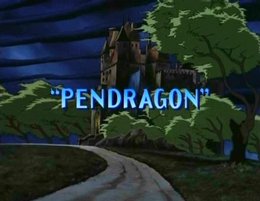Pendragon
"Pendragon" is the forty-eighth televised episode of the series Gargoyles, and the thirty-fifth episode of Season 2. It originally aired on February 12, 1996.
- Story edited by: Brynne Chandler Reaves
- Written by: Lydia Marano
- Directed by: Dennis Woodyard
Contents
Summary
Continuity
King Arthur appears for the first time since "Avalon Part Three". He teams up with Griff, who appears for the first time since "M.I.A.". They next appear in "The Rock".
Hudson and the Trio appear for the first time since "Kingdom".
The Stone of Destiny was introduced in "City of Stone Part Three", but plays an active role in this episode, speaking to Arthur (and being revealed as the stone from the Sword in the Stone). The Stone also reappears in "The Rock".
Banquo and Fleance appear in Macbeth's service for the last time (they had most recently appeared in "Sanctuary"). In their next appearance, in "Nightwatch", they are working for Castaway - which Macbeth briefly alludes to in "The Rock".
Hudson and the Trio allude to Goliath's adventures in "Golem" and "Mark of the Panther" (which they were informed of by Halcyon Renard and Diane Maza).
Tidbits
Greg Weisman intended "Pendragon" to be a back-door pilot to a spin-off, also entitled Pendragon, that would have dealt with King Arthur and Griff's adventures as they search for Merlin, adventures that would have taken them, among other places, to Tintagel, Stonehenge, and Antarctica. The Illuminati would have had a major role in this series as a recurring antagonist, particularly its leader, Mr. Duval, who would have turned out to be Sir Percival, a former knight of the Round Table that had survived into modern times through being the guardian of the Holy Grail. (This raises the question of how Percival can both be the Grail's guardian - an occupation that traditionally called for very high moral standards - and the head of an organization as amoral as the Illuminati. Greg commented once that Percival has had to pay a certain price for his actions as leader of the Illuminati, though he has so far refused to specify what that price was.) Arthur and Griff would also be joined by Percival's estranged wife, Blanchefleur, who would become a third regular. Unfortunately, the spin-off was never made (it is a sad commentary on television animation that Pendragon was rejected, while the dreadful King Arthur and the Knights of Justice received two full seasons).
Alert viewers will notice that Arthur could not have reached London immediately after leaving Avalon (since the events of "M.I.A.", "Golem" and "Mark of the Panther" have already taken place). According to Greg Weisman, Arthur had an unspecified adventure in the outside world that troubled him enough that he decided to return to Avalon for a time, and he was brought to London after making a second venture into the outside world.
Gargoyles here follows the popular interpretation of Excalibur and the Sword in the Stone being one and the same, which was the case in the earliest Arthurian legends; in Malory's Le Morte d'Arthur, they were, in fact, separate swords. After Arthur broke his old sword (Malory does not say whether it was the Sword in the Stone or a lesser weapon) while fighting King Pellinore, Merlin brought him to the Lady of the Lake, who gave him Excalibur via the famous hand rising up from her lake garbed in a sleeve of white samite. "Pendragon" makes use of both concepts, having Excalibur once again embedded in stone (but this time, completely encased, with the sword seemingly thrust in the stone being just a worthless lookalike), but bringing in the Lady of the Lake as instrumental in its recovery.
The Will-O-The-Wisp that Macbeth uses to spy on Arthur, Griff, and the remaining members of the Manhattan Clan, is an interesting take on the common cartoon plot device of "villain with cameras everywhere". This is a common scene in action adventure cartoons where the heroes are discussing something of importance. The view usually goes to a high angle shot and the camera pull back to reveal the villain watching and listening through a monitor or other viewing device. The antagonist is able to view and overhear just what he or she needs to, despite the fact that the heroes are in their base, the sky, some place they've never been before, or another location where their foe would be highly unlikely to place a remote camera. A magical entity, its powers augmented with science, get around the problem of how Macbeth manages to eavesdrop on our heroes from a distance.
An issue left unresolved is the Stone of Destiny's identity as being the stone from the Sword in the Stone. The Stone of Destiny was (according to Scottish tradition) brought to Scotland from Ireland around the year 500, to eventually become a crucial part of Scottish coronation ritual from 843 (when Kenneth mac Alpin became the first King of Scotland) to 1296 (when Edward I captured it and brought it to Westminster Abbey). Thus it did not reach London until almost eight hundred years after Arthur carried out his famous act of pulling the sword from the stone (which Malory places in London). So how can the two stones be the same? Greg has hinted that the Stone of Destiny was briefly moved to London and back for the occasion, but has declined to go into details; no doubt they will be revealed in the Stone of Destiny story now running in the Gargoyles comic book.
Links
| << Previous Episode: "Mark of the Panther" | Next Episode: "Eye of the Storm" >> |
